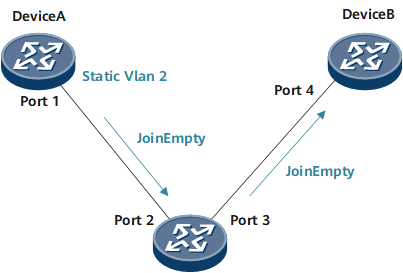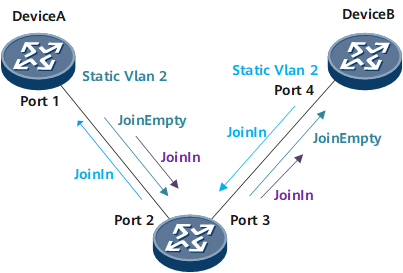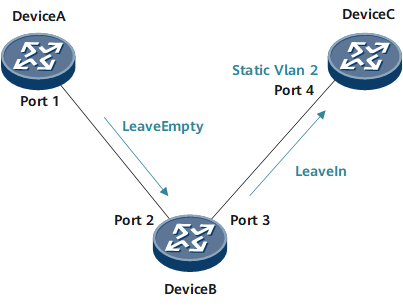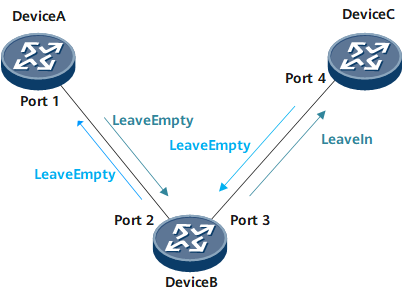Working Procedure
This section provides examples to illustrate how GVRP registers and deregisters a VLAN attribute on a network.
One-Way Registration

After VLAN 2 is manually created on Device A, Port 1 of Device A starts the Join timer and Hold timer. When the Hold timer expires, Port 1 sends the first JoinEmpty message to Device B. When the Join timer expires, Port 1 restarts the Hold timer. When the Hold timer expires again, Port 1 sends the second JoinEmpty message.
Upon receipt of the first JoinEmpty message, Device B creates dynamic VLAN 2, adds Port 2 to VLAN 2, and requests Port 3 to start the Join timer and Hold timer. When the Hold timer expires, Port 3 sends the first JoinEmpty message to Device C. When the Join timer expires, Port 3 restarts the Hold timer. When the Hold timer expires again, Port 3 sends the second JoinEmpty message to Device C. After Port 2 of Device B receives the second JoinEmpty message from Port 1, Port 2 of Device B leaves the JoinEmpty message unprocessed because Port 2 has been added to VLAN 2.
After Port 4 of Device C receives the first JoinEmpty message, Device C creates dynamic VLAN 2 and adds Port 4 to VLAN 2. After Port 4 of Device C receives the second JoinEmpty message, Port 4 leaves the JoinEmpty message unprocessed, because Port 2 has been added to VLAN 2.
Each time a LeaveAll timer expires or a LeaveAll message is received, each device restarts the LeaveAll timer, Join timer, Hold timer, and Leave timer. Then, Port 1 of Device A repeats step 1 to send JoinEmpty messages. Port 3 of Device B sends JoinEmpty messages to Device C in the same way.
Two-Way Registration

Manually create VLAN 2 on Device C after one-way registration is complete (the dynamic VLAN is replaced by the static VLAN). Port 4 of Device C starts the Join timer and Hold timer. When the Hold timer expires, Port 4 sends the first JoinIn message (because it has registered VLAN 2) to Device B. When the Join timer expires, Port 4 restarts the Hold timer. When the Hold timer expires again, Port 4 sends the second JoinIn message to Device B.
Upon receipt of the first JoinEmpty message, Device B adds Port 3 to VLAN 2 and requests Port 2 to start the Join timer and Hold timer. When the Hold timer expires, Port 2 sends the first JoinIn message to Device A. When the Join timer expires, Port 2 restarts the Hold timer. When the Hold timer expires again, Port 2 sends the second JoinIn message to Device A.
After Port 3 of Device B receives the second JoinIn message from Port 4, because Port 3 has been added to VLAN 2, Port 3 leaves the JoinIn message unprocessed.
After Device A receives the first JoinIn message from Port 2, it stops sending JoinEmpty messages to Device B. Each time a LeaveAll timer expires or a LeaveAll message is received, each device restarts the LeaveAll timer, Join timer, Hold timer, and Leave timer. When the Hold timer of Device A's Port 1 expires, Port 1 sends a JoinIn message to Device B.
Device B sends a JoinIn message to Device C.
Upon receipt, Device C does not create dynamic VLAN 2 because it has static VLAN 2 created.
One-Way Deregistration

Manually delete static VLAN 2 from Device A. Port 1 of Device A starts the Hold timer. When the Hold timer expires, Port 1 sends a LeaveEmpty message to Device B. The LeaveEmpty message needs to be sent only once.
Upon receipt, Port 2 of Device B starts the Leave timer. When the Leave timer expires, Port 2 deregisters VLAN 2. Because Port 3 is still in VLAN 2, VLAN 2 still exists on Device B. Device B then requests Port 3 to start the Hold timer and Leave timer. When the Hold timer expires, Port 3 sends a LeaveIn message to Port 4 of Device C. Upon receipt, Port 4 does not deregister VLAN 2 because VLAN 2 is a static VLAN on Device C. Because static VLAN 2 still exists on Device C, Port 3 still receives the JoinIn message from Port 4 before the Leave timer expires. That means that both Device A and Device B still learn dynamic VLAN 2.
- After Device C receives the LeaveIn message, Port 4 does not deregister VLAN 2 because VLAN 2 is a static VLAN on Device C.
Two-Way Deregistration

Manually delete static VLAN 2 from Device C. Port 4 of Device C starts the Hold timer. When the Hold timer expires, Port 4 sends a LeaveEmpty message to Device B.
Upon receipt, Port 3 of Device B starts the Leave timer. When the Leave timer expires, Port 3 deregisters VLAN 2. Dynamic VLAN 2 is then deleted from Device B. Device B then requests Port 2 to start the Hold timer. When the Hold timer expires, Port 2 sends a LeaveEmpty message to Device A.
Upon receipt, Port 1 of Device A starts the Leave timer. When the Leave timer expires, Port 1 deregisters VLAN 2. Dynamic VLAN 2 is then deleted from Device A.